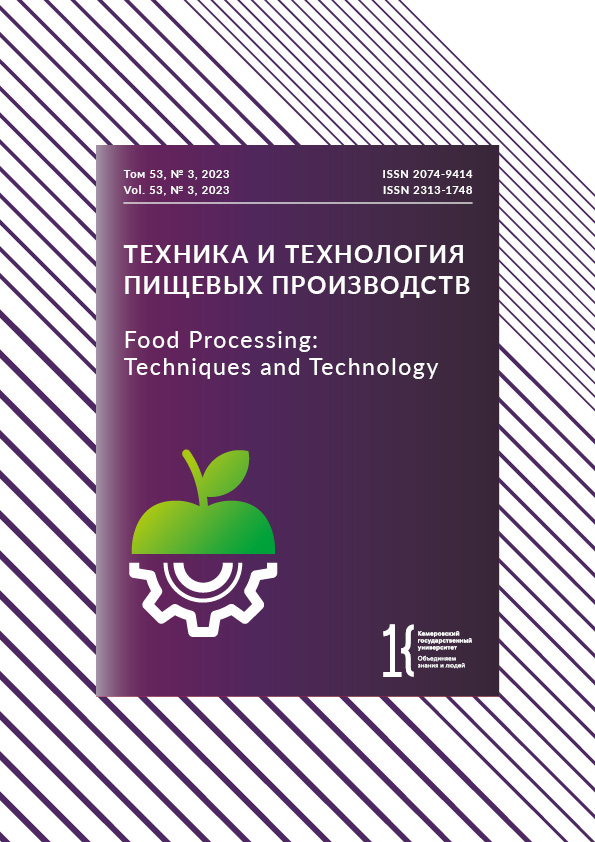from 01.01.2008 until now
Volgograd, Volgograd, Russian Federation
Volgograd, Volgograd, Russian Federation
Volgograd, Volgograd, Russian Federation
Chickpea (Cicer arietinum L.) is rich in protein and has a balanced amino acid profile. However, its characteristic bean flavor limits its use as a functional food ingredient. Microwave treatment may help to solve this problem. The research objective was to select the optimal parameters of microwave treatment to obtain chickpea samples with no bean flavor and to study their chemical composition. The study featured chickpeas of the Volzhanin variety. The experimental samples were processed in a microwave oven with a magnetron frequency of 2450 MHz at different power and time values. The protein tests, the analysis of amino acid profile, and the sensory assessment involved standard research methods. The microwave processing loosened the consistency of chickpeas and eliminated the bean flavor after 5–6 min at 200 W or 3 min at 400 W. A longer treatment time resulted in a peanut flavor followed by bitterness. The microwave treatment reduced the mass fraction of protein and the amount of essential amino acids. This process could be slowed down by increasing the power of microwave radiation and reducing the processing time. However, the intensification had a negative effect on the content of arginine, methionine, and tyrosine in chickpea protein. The results obtained can make it possible to use chickpeas as a functional food ingredient.
Cicer arietinum L., vegetable protein, amino acid composition, microwave proce ssing, functional products
1. Oryeshkin MV. The problem of protein deficiency - approaches to. Bulletin of the Luhansk National University. 2017;4(1):19-22. (In Russ.).
2. Langyan S, Yadava P, Khan FN, Dar ZA, Singh R, Kumar A. Sustaining protein nutrition through plant-based foods. Frontiers in Nutrition. 2022;8. https://doi.org/10.3389/fnut.2021.772573
3. Ahmed MH, Vasas D, Hassan A, Molnár J. The impact of functional food in prevention of malnutrition. PharmaNutrition. 2022;19. https://doi.org/10.1016/j.phanu.2022.100288
4. Ndinchout AS, Chattopadhyay D, Ascension NM, Kaur V, Singh N, Paul MF. Muffins fortified with Dacryodes macrophylla L. fruit: quality and sensory evaluation. Foods and Raw Materials. 2022;10(1):40-50. https://doi.org/10.21603/2308-4057-2022-1-40-50.
5. Chandrasekaran S, Luna-Vital D, de Mejia EG. Identification and comparison of peptides from chickpea protein hydrolysates using either bromelain or gastrointestinal enzymes and their relationship with markers of type 2 diabetes and bitterness. Nutrients. 2020;12(12). https://doi.org/10.3390/nu12123843
6. Khramova VN, Gorlov IF, Zhivotova TYu, Martynov AA, Martynova SV. The possibility of using the products of processing of chickpea raw material in sausage production. Proceedings of Lower Volga Agro-University Complex: Science and Higher Education. 2017;48(4):176-183. (In Russ.).
7. Madurapperumage A, Tang L, Thavarajah P, Bridges W, Shipe E, Vandemark G, et al. Chickpea (Cicer arietinum L.) as a source of essential fatty acids - A biofortification approach. Frontiers in Plant Science. 2021;12. https://doi.org/10.3389/fpls.2021.734980
8. Kolpakova VV, Kulikov DS, Ulanova RV, Chumikina LV. Food and feed protein preparations from peas and chickpeas: Production, properties, application. Food Processing: Techniques and Technology. 2021;51(2):333-348. (In Russ.). https://doi.org/10.21603/2074-9414-2021-2-333-348
9. Muñoz-Almagro N, Morales-Soriano E, Villamiel M, Condezo-Hoyos L. Hybrid high-intensity ultrasound and microwave treatment: A review on its effect on quality and bioactivity of foods. Ultrasonics Sonochemistry. 2021;80. https://doi.org/10.1016/j.ultsonch.2021.105835
10. Liu J, Zhang J, Wang W, Hou H. Effects of microwave treatment on the stability and antioxidant capacity of a functional wheat bran. Food Science and Nutrition. 2021;9(5):2713-2721. https://doi.org/10.1002/fsn3.2230
11. Viji P, Rao BM, Debbarma J, Ravishankar CN. Research developments in the applications of microwave energy in fish processing: A review. Trends in Food Science and Technology. 2022;123:222-232. https://doi.org/10.1016/j.tifs.2022.03.010
12. Cao J-X, Wang F, Li X, Sun Y-Y, Wang Y, Ou C-R, et al. The influence of microwave sterilization on the ultrastructure, permeability of cell membrane and expression of proteins of Bacillus cereus. Frontiers in Microbiology. 2018;9. https://doi.org/10.3389/fmicb.2018.01870
13. Korolev AA, Tyurina SB, Trishkaneva MV. The application of microwave radiation for sterilization of plant raw materials. Processes and Food Production Equipment. 2019;(3):81-91. (In Russ.). https://doi.org/10.17586/2310-1164-2019-12-3-81-91
14. Boukid F, Folloni S, Ranieri R, Vittadini E. A compendium of wheat germ: Separation, stabilization and food applications. Trends in Food Science and Technology. 2018;78:120-133. https://doi.org/10.1016/j.tifs.2018.06.001
15. Hu Q, He Y, Wang F, Wu J, Ci Z, Chen L, et al. Microwave technology: A novel approach to the transformation of natural metabolites. Chinese Medicine. 2021;16(1). https://doi.org/10.1186/s13020-021-00500-8
16. Jiang H, Liu Z, Wang S. Microwave processing: Effects and impacts on food components. Critical Reviews in Food Science and Nutrition. 2018;58(14):2476-2489. https://doi.org/10.1080/10408398.2017.1319322
17. Khan SH, Butt MS, Sharif MK, Sameen A, Mumtaz S, Sultan MT. Functional properties of protein isolates extracted from stabilized rice bran by microwave, dry heat, and parboiling. Journal of Agricultural and Food Chemistry. 2011;59(6):2416-2420. https://doi.org/10.1021/jf104177x
18. Gorlov IF, Semenova IA, Surkova SA, Barmina TN, Knyazhechenko OA, Mosolov AA. Method of inactivation of anti-nutrients in legumes intended for socially-oriented nutrition. Agrarian-and-Food Innovations. 2019;8(4):74-81. (In Russ.). https://doi.org/10.31208/2618-7353-2019-8-74-81
19. Gao Y, Xia H, Sulaeman AP, de Melo EM, Dugmore TIJ, Matharu AS. Defibrillated celluloses via dual twin-screw extrusion and microwave hydrothermal treatment of spent pea biomass. ACS Sustainable Chemistry and Engineering. 2019;7(13):11861-11871. https://doi.org/10.1021/acssuschemeng.9b02440
20. Sá AGA, Laurindo JB, Moreno YMF, Carciofi BAM. Influence of emerging technologies on the utilization of plant proteins. Frontiers in Nutrition. 2022;9. https://doi.org/10.3389/fnut.2022.809058
21. López-Moreno M, Garcés-Rimón M, Miguel M. Antinutrients: Lectins, goitrogens, phytates and oxalates, friends or foe? Journal of Functional Foods. 2022;89. https://doi.org/10.1016/j.jff.2022.104938
22. Lysikov YuA. Amino acids in human nutrition. Experimental and Clinical Gastroenterology Journal. 2012;(2):88-105. (In Russ.).











